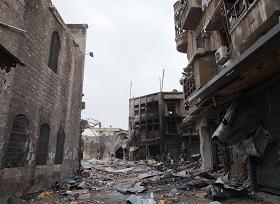Using AI to control energy for indoor agriculture
30 September 2024
Published online 5 September 2013

Syria's rich cultural heritage, which stretches back to the beginnings of human history, is at risk as fighting ravages the country.
Gathering accurate information is a challenge, but despite the violence, archaeologists and citizens have been trying to document the destruction of historical sites in the wake of all international archaeological missions leaving Syria.
From Babylonians to Arabs and the Crusaders, numerous civilisations have left their mark on Syria. Six of the country's sites appear on UNESCO's World Heritage Sites list: Damascus, Aleppo, the Crac des Chevaliers, Palmyra, Bosra and the Ancient Villages in Northern Syria. Hundreds of monuments are on UNESCO's Tentative List, and the national heritage register also boasts a wealth of treasures.
Since the unrest began in March 2011, the destruction of cultural sites has often been reported. The cause of damage ranges from shelling and gunfire to army occupation and bombing. Rampant looting and illegal developments on unguarded archaeological sites is also rife.
Syria's Directorate-General of the Antiquities and Museums (DGAM) is the authority in charge of the maintaining, safeguarding and preserving the country's heritage, but the ongoing conflict makes DGAM's remit increasingly difficult.
Before the violence started, about 180 national and international archaeological missions were represented in Syria, but they all left the country in 2011.
No clear policy exists for describing and properly conserving the antiquities.
As violence intensifies, gathering data becomes more dangerous, but an archive of damaged monuments is being compiled by academics and the public in a dedicated multi-lingual Facebook page, Syrian Archaeological Heritage Under Threat.
"The Facebook page gathers information to help future restoration missions," explains Rodrigo Martin Galan, one of the page administrators and a former archaeologist in Syria. "Destroyed sites cannot be reconstructed, but efficient restoration techniques exist which require not only lots of time and money, but detailed and accurate information on the monuments."
Despite appeals from UNESCO, the destruction continues. "It is impossible for us to get back there and protect the sites," says Galon. "Local practitioners do their best, but international missions do not enter Syria any more. The Assad government has put a lot of pressure on us. In 2011, foreign archaeologists under contract with the Syrian Ministry of Antiquities went on peaceful demonstrations in Europe and were later on all fired for sedition."
Leaked documents indicate the government has been warned of gangs targeting antiquities and Interpol is investigating stolen antiquities, but looting and smuggling continue.
Some artefacts are stolen and sold for private profit, but others are smuggled out for protection. "Despite political claims that our heritage is our biggest treasure, no clear policy exists for describing and properly conserving the antiquities," says S.A. *, a Syrian archaeologist.
"Sometimes when something disappears, a few even suspect it existed, thus I decided to place the objects I can put my hands on in safe places outside Syria. No museum out there accepts them, but archaeologists who formerly worked in Syria help me. It is a Herculean task to safeguard these treasures, but I believe they are safer now than if they remained in Syria."
"Huis Clos"This is our history; we want to rebuild it by ourselves for it to be the people’s heritage.
There is no national policy governing research on historical heritage and the dearth of international archaeological missions has left artefacts and monuments vulnerable. Previous restoration and inventory initiatives were all down to those missions' efforts.
"The government has never taken the time to draft and implement such a policy. Take, for instance, the museum in Damascus; to document all the objects in its store rooms would take five years and a full-time dedicated team," says Ali Othman, archaeologist and researcher with the DGAM. "Successive governments have signed all sorts of international agreements to create documentation centres and protect the cultural heritage in times of war. But the Assad government is not respecting them."
Shocking images of destruction, such as the bombing of the Umayyad Mosque in Aleppo or the ghost city of Homs, have been carried by the world's media. There was an outcry at a perceived lack of UNESCO action, but Othman says the international body is helpless. "All historical sites and museums are under the direct responsibility of the DGAM and the High Commission of Antiquities, which themselves directly depend on the Ministry of Culture."
Othman says the DGAM archaeologists are the only ones in the country able to protect its history,
"Campaigns to raise awareness, to prevent archaeologists from selling antiquities and documenting them are ongoing," adds Otham. "In this huis clos, we need to find our way through to safeguard our heritage. This is our history; we want to rebuild it by ourselves for it to be the people's heritage and not a tool in some religious or political battle."
doi:10.1038/nmiddleeast.2013.149
Stay connected: